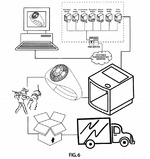 The legalities behind the KraftWurx 3D print service/software are now available for public viewing, courtesy of the US Government’s Patent and Trade office. Patent application number 20110313878, entitled “Made-to-order direct digital manufacturing enterprise” includes this abstract:
The legalities behind the KraftWurx 3D print service/software are now available for public viewing, courtesy of the US Government’s Patent and Trade office. Patent application number 20110313878, entitled “Made-to-order direct digital manufacturing enterprise” includes this abstract:Methods and systems for designing and producing a three-dimensional object selection of a base three-dimensional object from a customer device. A base three-dimensional model corresponding to the object is displayed on the customer device, and one or more custom modifications are received. A modified three-dimensional model corresponding to the modified object is prepared and displayed. Once confirmation to produce the modified object is received, data corresponding to the modified three-dimensional model is transmitted to a manufacturing device for production of the object, using the data to do so, such that the object corresponds directly to the modified three-dimensional model.
What does this mean? We believe this could be interpreted as a method to customize a partial design in order to build unique, one-off 3D objects. This is precisely what several other popular 3D print services do today, including Shapeways. We’re wondering how this will affect Shapeways, as they could be seen as violating this particular patent.
The patent covers not only the consumer side of the customization operation, but also the behind the scenes processing that must take place. Included are detailed descriptions of:
- Website operations
- Customer order processing
- Customized 3D view preparation
- Customer database
- Customized design creation
- Production management
- Print job optimization
- Build optimization
- Payment processing
- Materials management
- Remote printing management
- Quality tracking
- And more..
Things could get very interesting in the 3D print services business in 2012!
BTW, the FreePatentsOnline site is immensely easier to use than the official US Patent site; we’d recommend you view the patent there.


Very interesting patent. I like the concept and see nothing that makes it un-patent worthy. As a 3d artist / digital sculptor I am very much in-touch with the recent developments in 3d printing technology. I hardly think its garbage. It is refreshing to see at least one company out there is smart enough to predict where the market is going and preparing for it.
What left field did KraftThis come from? Patents are Patents. Whether you think the holder is "entitled" to it or not. Some sort of anger is easy to sense in KraftThis's reaction. But hey, we cannot all come up with the best patents first.
I think that the posts here are indicative of a reaction by someone with a vested interest in seeing the patent NOT awarded…
I find it interesting that not only did Kraftwurx apparently have the entire idea in writing in 2006 (based on the date of the provisional application) but that they did so as comprehensively as they did.
Patent reform aside…which I also believe to be necessary, this patent may very well be awarded…eventually. Will it hurt anyone?
By the way, did anyone see this link before: http://fabbaloo.com/blog/2012/1/6/kraftwurxs-patent-available.html?
This is a joke and a waste of their resources… Congrats to them.
Let them spend 10k on this garbage. Where is the common sense… Just makes me question the organizations motivation and direction.
Seriously, they are in no way entitled to this business plan being patented.
Well, we did say "Patent application number 20110313878", which suggests it's an "application" and not a "grant". But nevertheless, many people may not be clear on the difference. Applications ruminate through the legal system for years until they may (or may not) eventually be granted. As for being a business process, that seems to be commonly done these days. We'd like to hear Kraftwurx's reaction to the prior art comment!
3 things:
– the article should make it more clear that this is a patent application, not a granted patent
– looks more like an attempt to patent a business model than an invention to me
– and there's prior art on most of the claims…